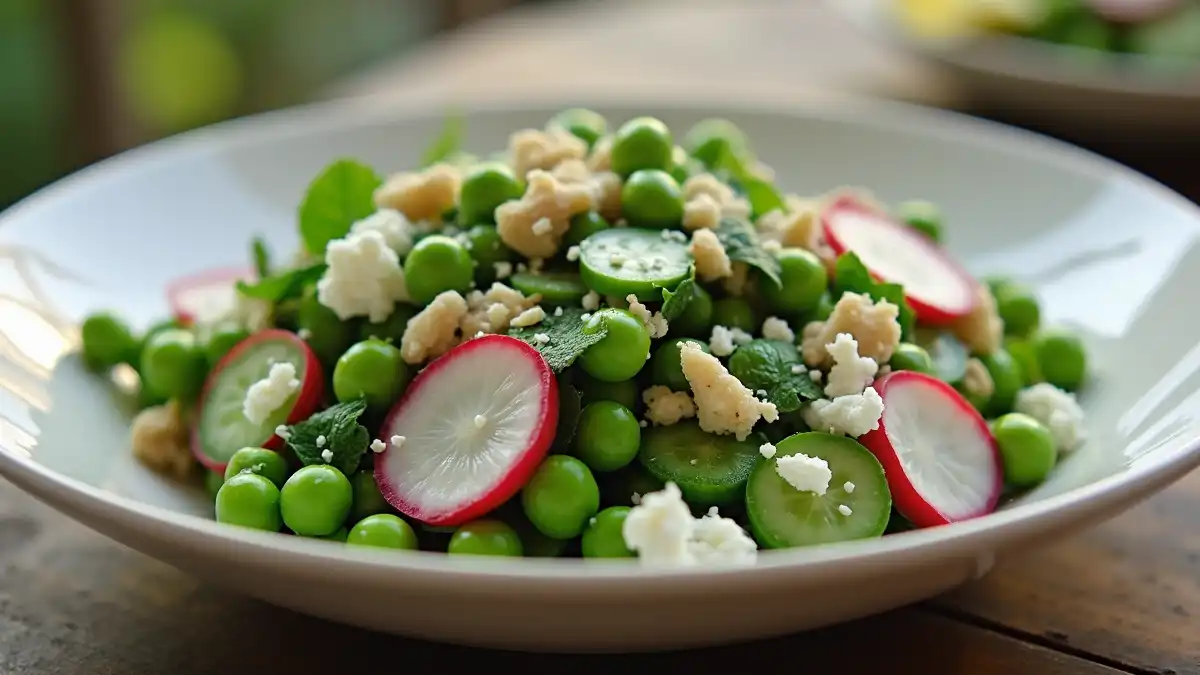
Table of Contents
Spring Pea Salad: A Fresh and Vibrant Seasonal Recipe
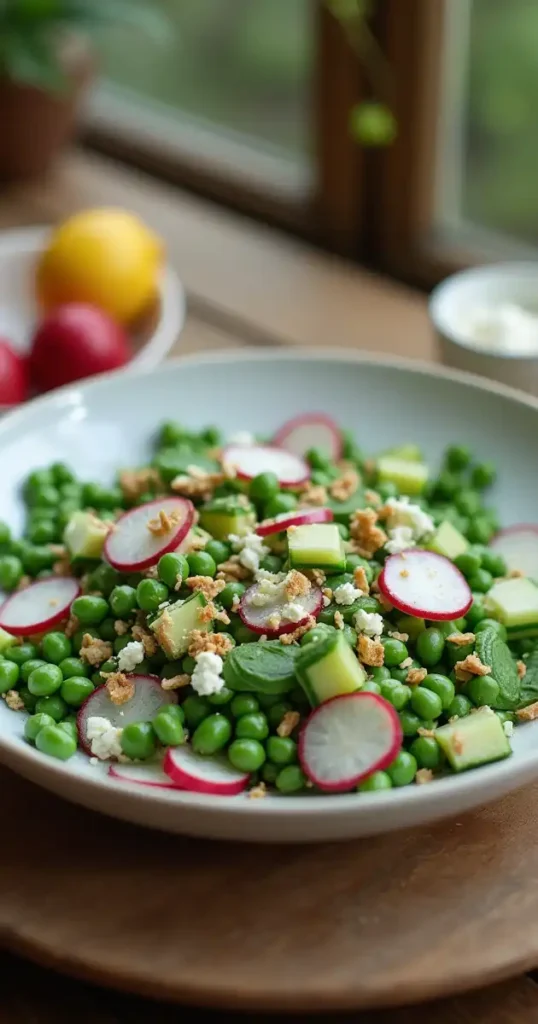
The arrival of spring brings with it the promise of vibrant, fresh produce, and nothing captures the essence of the season quite like a bowl of bright green spring pea salad. This delightful dish combines the sweet pop of tender peas with crisp vegetables and a light, zesty dressing that celebrates the flavors of renewal. Whether you’re looking for a healthy spring pea salad to brighten your lunch or an easy spring pea salad recipe to accompany your dinner, this versatile dish delivers both nutritional benefits and incredible taste in every bite.
In this comprehensive guide, I’ll share my perfected spring pea salad recipe that has delighted friends and family for years, along with expert tips for selecting the best ingredients, time-saving preparation methods, and creative variations to suit any palate or dietary preference, including a spectacular vegan spring pea salad option. By the end, you’ll have everything you need to create a showstopping salad that embodies the fresh promise of spring.
What is Spring Pea Salad?
Spring pea salad is a seasonal dish that showcases fresh spring peas in their prime. Traditionally, it combines tender peas with complementary vegetables, herbs, and a light dressing that enhances rather than masks the delicate sweetness of the peas. The classic version often includes elements of creaminess from cheese or yogurt, crunch from fresh vegetables or nuts, and brightness from citrus or vinegar.
“Spring peas are nature’s candy—sweet little bursts of flavor that need minimal intervention to shine. A good spring pea salad should celebrate their natural perfection.” – Chef Alice Waters
What makes spring pea salad particularly special is its celebration of seasonality. When peas are at their peak in spring, they contain a natural sweetness and tenderness that frozen peas simply cannot match (though frozen peas make an excellent substitute when fresh aren’t available). This seasonal delicacy transforms a simple salad into a standout dish that captures the essence of springtime on a plate.
Why This Recipe is Better
While many spring pea salad recipes exist, this version stands apart for several key reasons:
1. The Perfect Blanching Technique
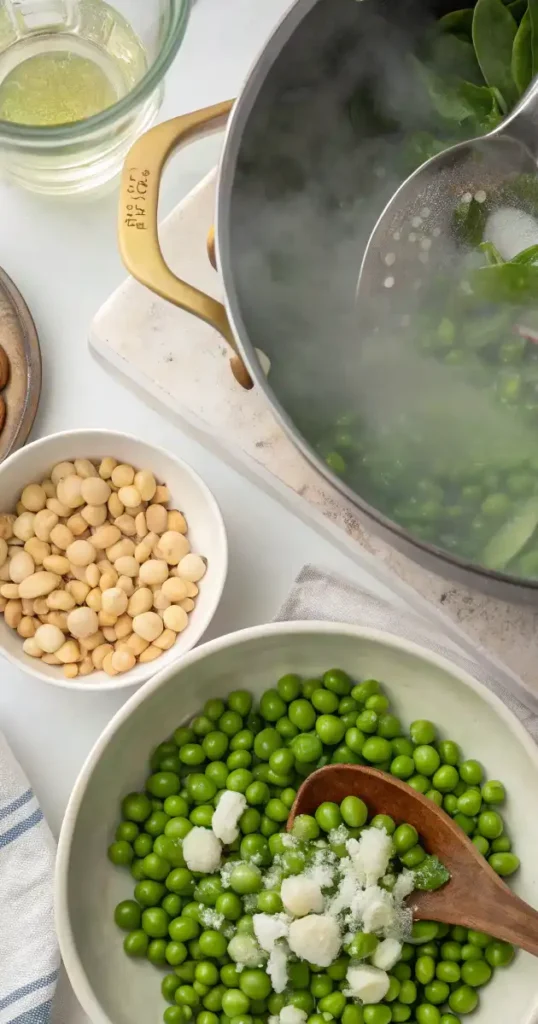
Most recipes simply tell you to blanch peas, but the timing is crucial. My technique—exactly 90 seconds in boiling water followed by an ice bath—ensures peas that remain bright green with the perfect tender-crisp texture. This precision prevents the mushiness that plagues many pea salads.
2. Layered Flavor Building
Rather than just tossing ingredients together, this recipe builds flavor in stages. By briefly sautéing the shallots and toasting the nuts, we develop deeper, more complex flavors that elevate the entire dish beyond a simple salad.
3. Versatility Without Compromise
While many recipes offer variations as an afterthought, this spring pea salad was developed with adaptability in mind. The core recipe remains delicious with any of the suggested modifications, making it truly customizable for dietary preferences without sacrificing taste.
4. Temperature Flexibility
Unlike many salads that must be served cold, this spring pea salad shines at various temperatures—warm, room temperature, or chilled—making it perfect for both immediate serving and make-ahead preparation.
5. The Secret Dressing
The lemon-mint dressing includes a small amount of honey and Dijon mustard that creates a perfectly balanced emulsion. This combination enhances the natural sweetness of the peas while adding complexity that many other recipes lack.
Ingredients List
For the perfect spring pea salad that serves 4-6 people, you’ll need:
For the Salad Base:
- 3 cups fresh peas (about 3 pounds unshelled) or 3 cups frozen peas, thawed
- 1 cup sugar snap peas, strings removed and sliced on the diagonal
- 2 medium radishes, thinly sliced
- 1 small English cucumber, diced (about 1 cup)
- 3 tablespoons finely chopped shallot (about 1 medium shallot)
- 1/4 cup fresh mint leaves, torn or roughly chopped
- 1/4 cup fresh chives, finely chopped
- 1/3 cup crumbled feta cheese (omit for vegan version)
- 1/4 cup toasted sliced almonds
For the Lemon-Mint Dressing:
- 3 tablespoons extra virgin olive oil
- 2 tablespoons fresh lemon juice
- 1 teaspoon lemon zest
- 1 teaspoon Dijon mustard
- 1 teaspoon honey (substitute maple syrup for vegan version)
- 1 small garlic clove, minced or grated
- 1 tablespoon finely chopped fresh mint
- Salt and freshly ground black pepper to taste
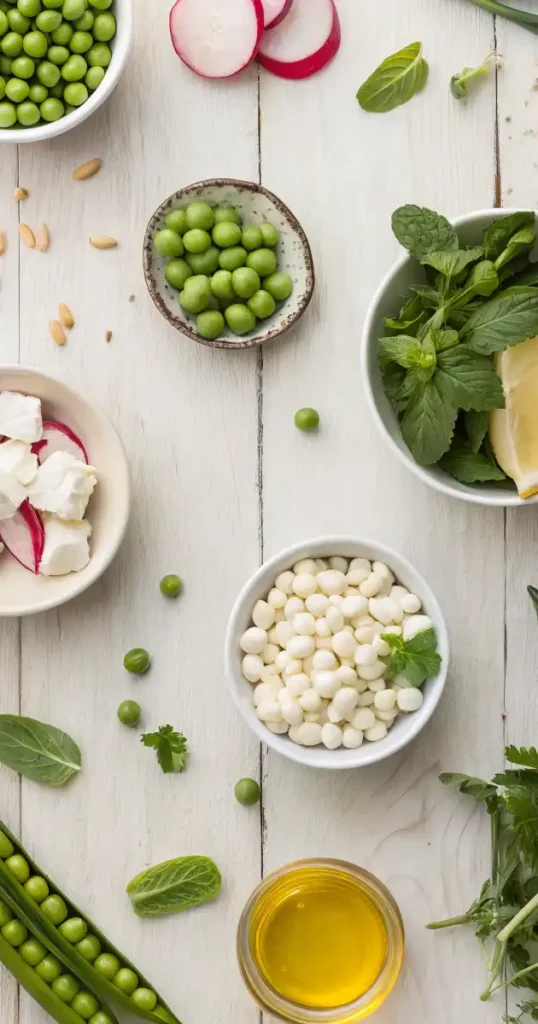
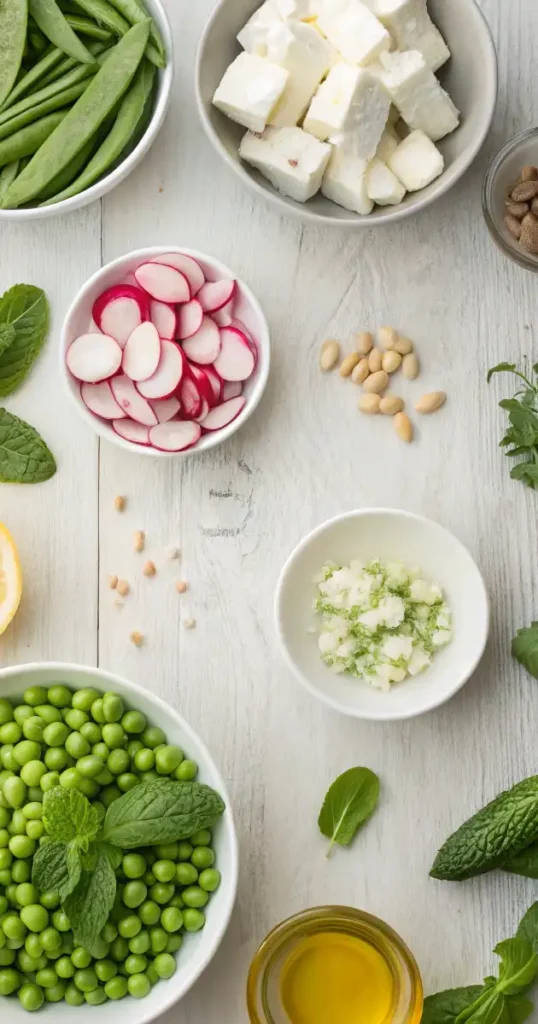
Equipment Needed:
- Large pot for blanching peas
- Large bowl of ice water for shocking peas
- Colander for draining
- Small skillet for toasting nuts and sautéing shallots
- Small jar with lid for mixing dressing
- Large mixing bowl
- Serving platter or bowl
Ingredient Notes:
- Fresh Peas: Look for bright green, plump pods that feel firm and heavy for their size. If unavailable, frozen peas work excellently—just thaw them under cool running water.
- Feta Cheese: Traditional sheep’s milk feta offers the best flavor, but any feta will work. For a dairy-free option, use a plant-based feta alternative or avocado chunks.
- Herbs: Fresh herbs are non-negotiable here—dried won’t provide the same bright flavor.
- Olive Oil: Use a good quality extra virgin olive oil as its flavor will be prominent in the dressing.
Step-by-Step Instructions
Preparing the Peas and Vegetables
- Prepare an ice bath: Fill a large bowl with water and ice cubes. Set aside.
- Blanch the peas: Bring a large pot of heavily salted water to a rolling boil. Add the fresh peas and cook for exactly 90 seconds. (If using frozen peas that are already thawed, reduce blanching time to 30 seconds.)
- Shock the peas: Immediately drain the peas in a colander and transfer them to the ice bath. Let them cool completely, about 2 minutes, then drain thoroughly. Pat dry with paper towels to remove excess moisture.
- Prepare the sugar snap peas: Remove the strings from the sugar snap peas by pinching the stem end and pulling along the length of the pod. Slice them diagonally into thin pieces.
- Prepare the radishes and cucumber: Thinly slice the radishes using a sharp knife or mandolin. Dice the cucumber into 1/4-inch pieces.
Preparing the Add-ins
- Toast the almonds: In a small dry skillet over medium heat, toast the sliced almonds until fragrant and golden, about 3-4 minutes, stirring frequently to prevent burning. Transfer to a plate to cool.
- Sauté the shallots: In the same skillet, add 1 teaspoon of olive oil over medium heat. Add the chopped shallots and sauté until softened but not browned, about 2 minutes. Set aside to cool.
Making the Dressing
- Combine dressing ingredients: In a small jar with a tight-fitting lid, combine the olive oil, lemon juice, lemon zest, Dijon mustard, honey, minced garlic, chopped mint, 1/4 teaspoon salt, and a few grinds of black pepper.
- Emulsify the dressing: Secure the lid and shake vigorously until all ingredients are well combined and the dressing is emulsified. Taste and adjust seasoning if needed.
Assembling the Salad
- Combine the vegetables: In a large mixing bowl, combine the blanched peas, sliced sugar snap peas, cucumber, radishes, and cooled sautéed shallots.
- Add herbs and dressing: Add the torn mint leaves and chopped chives to the bowl. Pour about three-quarters of the dressing over the salad and toss gently to coat all ingredients.
- Final assembly: Transfer the salad to a serving platter or bowl. Sprinkle the crumbled feta cheese and toasted almonds over the top. Drizzle with remaining dressing if desired.
- Rest before serving: For best flavor, let the salad stand at room temperature for 15 minutes before serving to allow the flavors to meld.
Variations & Customizations
The beauty of spring pea salad lies in its adaptability. Here are several ways to customize the recipe to suit different preferences and dietary needs:
Protein Additions
- For meat lovers: Add 4 slices of cooked and crumbled bacon or 1/2 cup diced ham
- For seafood enthusiasts: Top with 1 cup cooked shrimp or flaked smoked salmon
- For vegetarians: Add 1 cup halved cherry tomatoes and an extra 1/4 cup crumbled feta
- For vegans: Add 1 cup chickpeas or 1/2 cup toasted pumpkin seeds for protein
Cheese Variations
- Replace feta with:
- Crumbled goat cheese for tangy creaminess
- Shaved Parmesan for savory depth
- Crumbled ricotta salata for a milder option
- Small fresh mozzarella balls for a subtle dairy note
Herb Variations
- Substitute or combine mint with:
- Fresh dill for an aromatic, anise-like flavor
- Basil for a summery Mediterranean twist
- Tarragon for a French-inspired variation
- Cilantro for a bright, citrusy note (pair with lime instead of lemon in the dressing)
Vegetable Additions
- Enhance the vegetable mixture with:
- 1 cup blanched asparagus tips (add to the peas during the last 30 seconds of blanching)
- 1/2 cup thinly sliced fennel for a subtle licorice flavor
- 1 ripe avocado, diced, added just before serving
- 1/2 cup microgreens as a garnish
Nut and Seed Variations
- Instead of almonds, try:
- Toasted pine nuts for buttery richness
- Chopped pistachios for color and nutty flavor
- Toasted pepitas (pumpkin seeds) for a nut-free option
- Sunflower seeds for a budget-friendly alternative
Dressing Variations
- Creamy Variation: Add 2 tablespoons of Greek yogurt to the dressing
- Herby Green Goddess: Blend the dressing with an additional 1/4 cup mixed herbs
- Asian-Inspired: Replace lemon juice with rice vinegar and add 1 teaspoon sesame oil and 1/2 teaspoon grated ginger
Serving Suggestions & Pairings
Spring pea salad is incredibly versatile when it comes to serving options:
As a Side Dish
Pairs beautifully with:
- Grilled salmon or chicken
- Roasted leg of lamb
- Spring risotto
- Quiche or savory tart
As a Main Course
Transform it into a complete meal by:
- Serving it over cooked farro or quinoa
- Adding a protein (see variations above)
- Pairing with crusty artisan bread and good butter
- Serving alongside a chilled soup like vichyssoise
For Special Occasions
- Easter Brunch: Serve alongside deviled eggs and ham
- Spring Picnic: Pack in individual jars with the dressing at the bottom
- Potluck Contribution: Double the recipe and transport the components separately, assembling just before serving
- Mother’s Day Lunch: Serve with champagne and strawberry shortcake for dessert
Beverage Pairings
- Wine: Crisp Sauvignon Blanc or unoaked Chardonnay
- Beer: Wheat beer or light pilsner
- Non-alcoholic: Sparkling water with cucumber and mint or a light iced green tea
Make-Ahead Tips & Storage
Preparation Timeline
For the freshest taste with make-ahead convenience:
Up to 2 days ahead:
- Make the dressing and store in a jar in the refrigerator
- Toast the nuts and store in an airtight container
Up to 1 day ahead:
- Blanch the peas, cool completely, and store in an airtight container
- Chop the herbs (except mint, which browns quickly)
- Prepare the cucumber and radishes, storing separately in airtight containers
Just before serving:
- Chop the mint
- Combine all prepared ingredients
- Add the dressing and toss
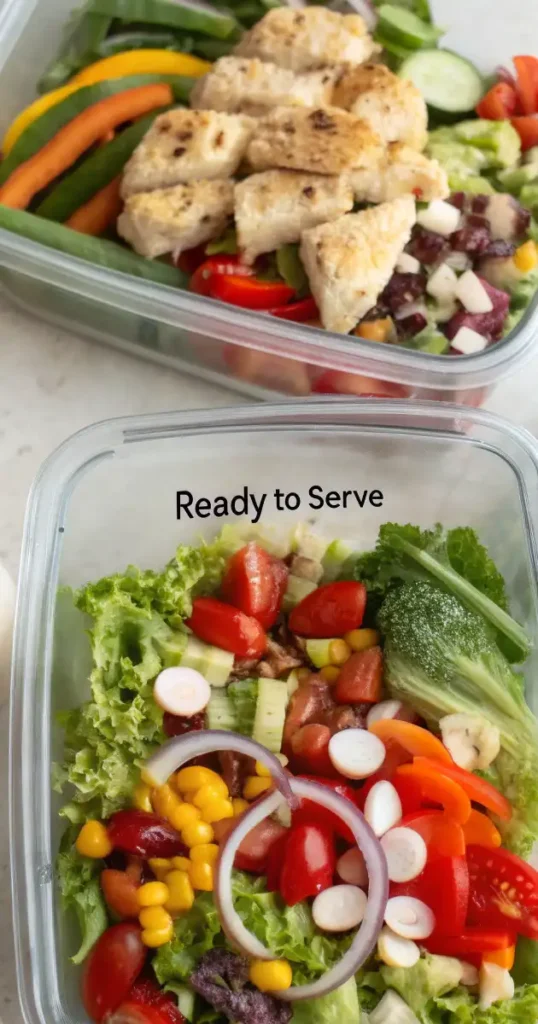
Storage Solutions
- Leftover dressed salad: Will keep in the refrigerator for up to 2 days, though the herbs may darken slightly
- Undressed components: Store separately in the refrigerator for up to 3 days
- Freezing: Not recommended, as the texture of the vegetables will suffer
Preventing Soggy Salad
- Thoroughly dry all ingredients after washing
- If preparing ahead, store wet ingredients (blanched peas) separately from dry ingredients (nuts, herbs)
- Add the dressing just before serving, or serve it on the side
- For potlucks, layer ingredients in a jar with dressing at the bottom, sturdier vegetables next, and delicate herbs on top
Frequently Asked Questions (FAQ)
Q: Can I use frozen peas instead of fresh?
A: Absolutely! Frozen peas are often picked and processed at peak freshness, making them an excellent alternative. Thaw them under cold running water and reduce the blanching time to 30 seconds, or skip blanching entirely for a time-saving option.
Q: How long does spring pea salad last in the refrigerator?
A: Dressed salad will last about 2 days in the refrigerator, though the herbs may darken. For best results, store undressed components separately for up to 3 days and assemble just before serving.
Q: How can I make this spring pea salad vegan?
A: Simply omit the feta cheese and substitute maple syrup for honey in the dressing. Add avocado for creaminess and chickpeas or toasted pepitas for protein.
Q: What’s the best way to shell fresh peas?
A: To shell fresh peas, snap the stem end and pull the string down the length of the pod. Open the pod along the seam and run your thumb along the inside to pop out the peas. One pound of pea pods typically yields about 1 cup of shelled peas.
Q: Can I use different types of peas?
A: Yes! This recipe works well with English peas, sugar snap peas, and snow peas. You can use one type exclusively or a combination. Adjust blanching times based on size—smaller peas need less time.
Q: How can I make this salad more substantial for a main dish?
A: Add a grain base like farro, quinoa, or orzo pasta, and include a protein such as grilled chicken, shrimp, or chickpeas. Increase the dressing by 50% to ensure adequate coverage.
Q: Are there any shortcuts for this recipe?
A: Use thawed frozen peas (skip blanching), pre-crumbled feta, and store-bought lemon vinaigrette. While not quite as flavorful as the full recipe, these shortcuts still yield a delicious salad in half the time.
Nutrition Information
Per serving (1/6 of recipe, approximately 1 cup)
| Nutrient | Amount |
| Calories | 185 |
| Total Fat | 11g |
| Saturated Fat | 2.5g |
| Cholesterol | 8mg |
| Sodium | 210mg |
| Total Carbohydrates | 17g |
| Dietary Fiber | 5g |
| Sugars | 7g |
| Protein | 7g |
| Vitamin A | 15% DV |
| Vitamin C | 40% DV |
| Calcium | 8% DV |
| Iron | 10% DV |
DV = Daily Value based on a 2,000 calorie diet
This healthy spring pea salad is high in fiber and vitamin C while being relatively low in calories. The healthy fats from olive oil and nuts make it satisfying despite its light profile.
A Year-Round Spring Pea Salad Solution
While this salad truly shines during spring when fresh peas are at their peak, don’t hesitate to enjoy this vibrant dish year-round. High-quality frozen peas allow you to capture the essence of spring whenever you need a bright, nutritious addition to your table.
Remember that the key to an outstanding spring pea salad isn’t just about the ingredients—it’s about treating each component with care. Take the time to properly blanch your peas, toast your nuts, and build layers of flavor. The extra few minutes of attention transform a simple salad into a memorable dish that celebrates the essence of spring.
I’d love to hear how your spring pea salad turns out! Leave a comment below sharing your experience or any creative variations you developed. If you enjoyed this recipe, please consider sharing it on social media or subscribing to our newsletter for more seasonal cooking inspiration.
Happy cooking and happy spring!